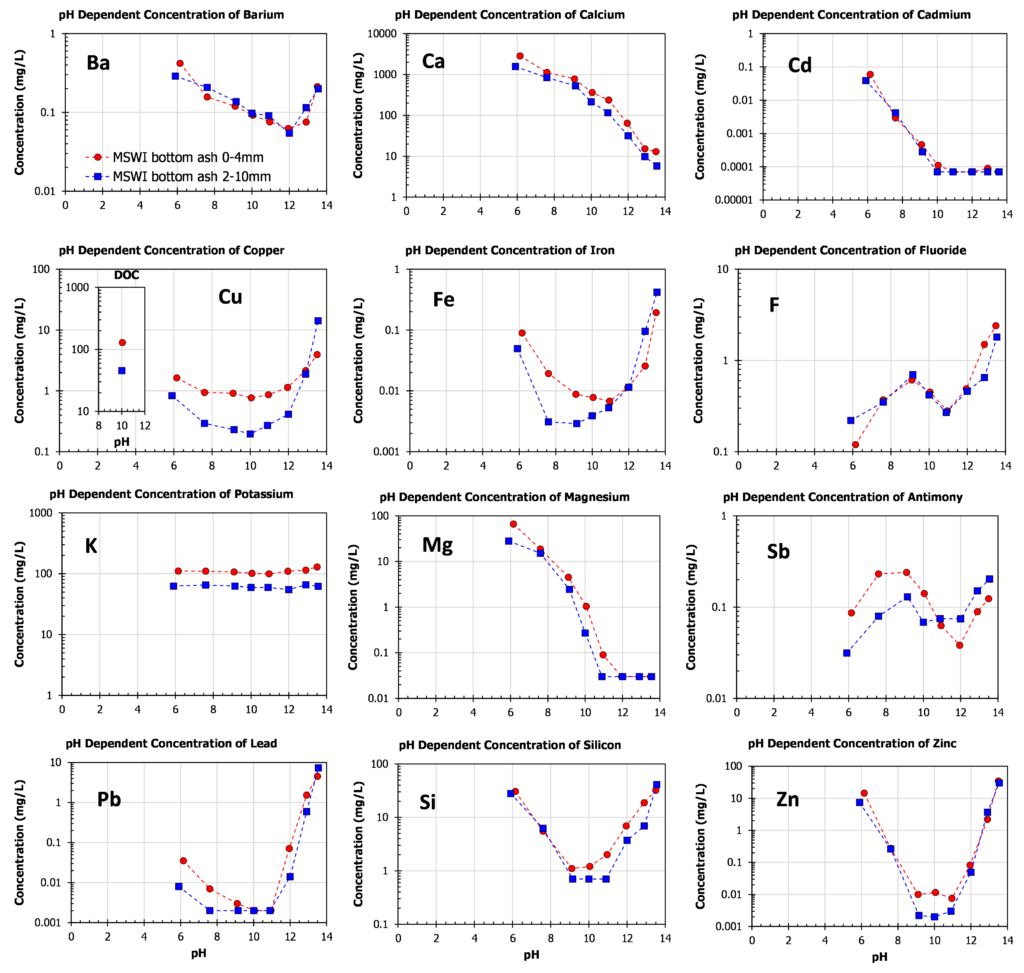Particle size
In principle, a sufficient number of particles is needed for a solid sample to be representative. However, this is not the only factor at play as a distinction must be made between content analysis and leaching of solids.
In content analysis sometimes rather small samples are processed, which puts additional requirements on sample representativity. This is generally solved by extensive size reduction. There are limits as metallic parts or plastics can not be size reduced that easily and may lead to large fluctuations in content when a subsample does or does not contain a small solid metal piece.
In leaching, additional factors play a role that limit the effect of particle size as solubility limitations have a large effect on leachability with pH as an important control variable. In leaching also the presence of organic matter and as a consequence dissolved organic matter plays a role.
In the graphs below the leaching of two MSWI bottom ash size fractions is presented using pH dependence leaching test (EN 14429). The fractions tested are the 0 mm – 4 mm fraction normally required in the standard and the 2 mm – 10 mm fraction separated from the original bottom ash laboratory sample. According to both number of particles and considerations relating to surface area, the results should not be as close as they appear to be. This is linked to the solubility control that governs leaching. If there is no solubility control the results obtained in the pH dependence test would result in a flat line, like the one observed for K. In case of Cu and Fe, the increased mobility in the pH range 6 – 11 is related to the different level of DOC in the 0 mm – 4 mm vs the 2 mm – 10 mm fraction. None of the other elements shown feature this type of release behaviour, which implies that for all other elements one or the other form of solubility control is active (mineral precipitation/dissolution, sorption to iron oxides or particulate and dissolved organic matter).

Leaching of MSWI bottom ash size fractions (0 – 4 mm; nominal median around 0.05 mm and 2 – 10 mm; nominal median around 3 mm) illustrating role of solubility controlled release and hence more significant effect of pH differences than an effect of particle size on release.
Apparatus
In batch leaching, an end over end tumbler or excentric roller table is the preferred agitation device as other types of agitation devices lead to too much size reduction (wrist shaker) of the test material or incomplete exposure (shaker table) to leachant.
Material issues
Performing a percolation test with alkaline flue gas treatment waste and similar materials with self-cementing properties may lead to disruption of the column apparatus when a peristaltic pump is applied for controlled leachate flow. As the material start to cement the net flow through the column decreases and pressure builds up. A solution to the problem is to pre-wet the material, thus allowing the cementation reaction to complete , then crush the materials and place in a column for percolation.
pH in eluates from alkaline materials misrepresented
When in the leaching tests with long contact times (percolation and monolith leaching) eluates are exposed to the surrounding atmosphere there is a substantial chance that the pH in resulting alkaline eluates is affected by uptake of CO2 from the laboratory atmosphere. This effect can be very large when carbonation experiments or other CO2 producing activities in the laboratory environment take place. The collection bottles should be closed off as much as possible and verification of the magnitude of the effect can be tested by placing a similar collection vessel filled with solution adjusted to pH 11 for the same period of the eluate collection cycles and measuring pH at regular intervals.
Heterogeneous materials
A few questions arise around this topic:
- How to identify heterogeneity?
- Is a material heterogeneous for all substances?
- What actions can be taken to resolve the issue of poor repeatability of test results?
- The clearest indication of heterogeneity is observed when the within lab repeatability as obtained from duplicate or triplicate testing shows a relative standard deviation exceeding 20 % assuming the measurement is taking place well above the limit of quantification (LOQ) and the analytical uncertainty for the substance of interest is well within 10 %.
- Heterogeneity can be very substance specific.
- In MSWI bottom ash, metals like Cu, Pb, Zn can be present as metallic pieces besides metal bound in mineral phases and bonded by sorption on iron oxide or associated with particulate and dissolved organic matter.
- Industrial slag can have layered structures of mineral phases with different chemical composition, which depending on the degree of exposure can result is differences in release (e.g. oxidised and reduced zones)
- Sand blasting waste was shown to be heterogeneous in pH in spite of a rather fine granular structure. This may be caused by using alkaline paint stripping agents, that form small inclusions that are rare enough to affect the pH of subsamples, which in leaching has consequences on leachability of specific elements.
- Solutions to the problem
- In case of MSWI bottom ash, the leachability of metals is not affected by the presence of a small fraction of metallic particles as the leachability is controlled by other forms in which the metals are present in this matrix. For metal recovery, obviously, this type of information is of the essence. In that case, analysis of multiple subsamples for content provides a better estimate of the true content, but in this particular case focusing on the metallic fraction by other separation techniques is more appropriate.
- In case of slags, analysis of multiple test portions may be the most appropriate means of getting a better and more representative test result.
- In the case of sand blasting waste, multiple testing and /or placing the test results in perspective to pH dependence test data for this material may provide a good solution for more reproducible results.
Overall, it is important in case of heterogeneous materials to keep the purpose of the testing in mind in finding a solution to a heterogeneity issue as it may not be relevant for the main purpose of the test as shown in the case of leaching of MSWI bottom ash for environmental impact evaluation.


